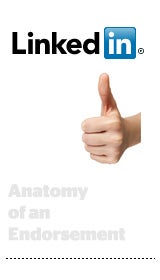 Since LinkedIn launched its heavily dissected LinkedIn Endorsements product last September, two billion endorsements have been made to date.
Since LinkedIn launched its heavily dissected LinkedIn Endorsements product last September, two billion endorsements have been made to date.
LinkedIn, which reported 37% year-over-year growth in membership in Q2, now has 238 million members and generated $364 million in revenue in the second quarter. The company is also flirting with an API to enable programmatic buying through the platform, calling it a high priority. “Products such as endorsements, which we introduced last year, continue to show accelerating engagement,” said CEO Jeff Weiner during the company’s second quarter earnings call yesterday.
He added, “Some endorsements hold more weight than others, so we are working to leverage our data to differentiate the value of an endorsement based on a number of factors.” Weiner went on to say that endorsements will be used to deliver relevant content to users and to help recruiters uncover the most relevant profiles on the network.
Since its inception, Endorsements have been called everything in the book, from “worthless” to “lots of noise, no signal,” the main point of contention being that users could be racking up reputations for skills they may have little to no merit in, since there is no way to truly verify that the individual doing the endorsing actually bore witness to the user performing the skill they’re being endorsed for.
There’s also the question of how an endorsement is weighted, since users can manage what endorsements – and endorsers – show up on their profiles to begin with. Or the fact that users are met at first glance with a prompt to “endorse” other users when landing on their profiles, which could be seen as intrusive.
When asked if all of this LinkedIn Endorsement data will be aggregated for targeted profiles or the like in order to pad out recruitment in-platform, Paul Slakey, LinkedIn’s director of global solutions and services said that there was nothing LinkedIn is announcing at present, but did note that “endorsements have the potential to provide insight into pools of talent.”
For example, he said, a company looking to hire or target JavaScript experts could essentially cull users who have a high number of LinkedIn endorsements for JavaScript in order to filter and select relevant candidates in a recruitment situation.
Or, hypothetically, it’s easy to see how an endorsement could correlate to impressions for job ad placements, what with LinkedIn’s recent debut of self-serve native ads. During yesterday’s earnings call, LinkedIn updated investors on its “transition to a more sustainable and scalable content marketing model,” and noted the success gained by early beta testers of native Sponsored Updates, which are now generally available. Social media marketing company HootSuite, for instance, converted leads using in-stream Sponsored Updates that were 22 times the rate of banner traffic at 32% less cost-per-lead. Marketing Solutions revenue was up 36%, coming in at $86 million this quarter.
LinkedIn, in the meanwhile, continues to accelerate its data outfit. One of LinkedIn’s principal data engineers, Sam Shah, has worked on the endorsements product along with other data-driven functions on the professional social platform, like “Who’s Viewed My Profile?” and “People You May Know.”
Shah has been a regular on the conference circuit, speaking about how the professional social platform uses advanced data algorithms to extract a taxonomy of skills about users to measure if a candidate possesses a key skill and then tailors that knowledge to recommend people to endorse. LinkedIn uses an open Hadoop infrastructure to run “big data” analysis through algorithms built in-house.
Endorsements, identified as a data feature in LinkedIn’s portfolio, are part of an ecosystem that “generates a large graph of reputation signals and viral user activity.” LinkedIn can apply complex, large-scale machine learning to extract variables in keywords. For example, it can use that keyword data to determine the “context” of a skill in Endorsements. The word “search” could stand for a retrieval of information or it could mean “search and rescue.”
Whether the next phase of LinkedIn Endorsements involves more than social tagging beyond clicking “endorse” in a Facebook-like fashion, remains to be seen, but it’s clear LinkedIn has a landfill of user-generated data that could bode well for Marketing Solutions clients down the road.












